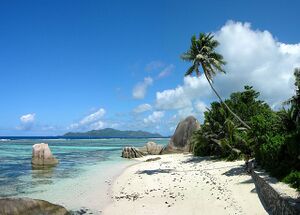
 California's first ever U.S. Indigenous Marine Stewardship Area declared, Liz Kimbrough, news.mongabay.com (Jan 29, 2024)
California's first ever U.S. Indigenous Marine Stewardship Area declared, Liz Kimbrough, news.mongabay.com (Jan 29, 2024)  Inside the DIY Movement to Fight Coastal Erosion, wired.co.uk (Jan 16, 2024)
Inside the DIY Movement to Fight Coastal Erosion, wired.co.uk (Jan 16, 2024)  Collaboration involving local fishing communities helps save manatees stranded in Colombia, news.mongabay.com (Dec 18, 2023)
Collaboration involving local fishing communities helps save manatees stranded in Colombia, news.mongabay.com (Dec 18, 2023)
According to the UN atlas, 44% of people live within 150 kilometres (93 miles) of the sea. W
Environmental importance: The coast and its adjacent areas on and off shore are an important part of a local ecosystem: the mixture of fresh water and salt water in estuaries provides many nutrients for marine life. Salt marshes and beaches also support a diversity of plants, animals and insects crucial to the food chain.
The high level of biodiversity creates a high level of biological activity, which has attracted human activity for thousands of years. W
Sea level rise: Sea level rises can considerably influence human populations in coastal and island regions and natural environments like marine ecosystems. Sea level rise is expected to continue for centuries. Because of the slow inertia – long response time for parts of the climate system, it has been estimated that we are already committed to a sea-level rise of approximately 2.3 meters for each degree of temperature rise within the next 2,000 years. W
Community action projects
- beach clean ups
- raise awareness of coastal communities threatened by Climate change, mitigation and adaption response options
Events
 Feb 02, 2024 (Fri) — World Wetlands Day
Feb 02, 2024 (Fri) — World Wetlands Day Mar 01, 2024 (Fri) — World Seagrass Day
Mar 01, 2024 (Fri) — World Seagrass Day May 6 - 12, 2024 (Mon - Sun) — Screen-Free Week
May 6 - 12, 2024 (Mon - Sun) — Screen-Free Week Jun 05, 2024 (Wed) — World Environment Day
Jun 05, 2024 (Wed) — World Environment Day Jun 08, 2024 (Sat) — World Oceans Day
Jun 08, 2024 (Sat) — World Oceans Day
Sea level rise
Societies can adapt to sea level rise in three different ways: implement managed retreat, accommodate coastal change, or protect against sea level rise through hard-construction practices like seawalls or soft approaches such as dune rehabilitation and beach nourishment. Sometimes these adaptation strategies go hand in hand, but at other times choices have to be made among different strategies. For some human environments, such as so called sinking cities, adaptation to sea level rise may be compounded by other environmental issues such as subsidence. Natural ecosystems typically adapt to rising sea levels by moving inland; however, they might not always be able to do so, due to natural or artificial barriers. W
Maps
Land projected to be below annual flood level in 2030 and beyond, coastal.climatecentral.org
Sea Level Rise, information from climatecentral.org
Resources
Organisations working with communities
Blue Ventures is a registered charity focused on nurturing locally led marine conservation. The organisation partners with coastal communities that depend on marine resources.
Blue Ventures' marine management models aim to combine community-led resource management, community health, and alternative livelihood initiatives for the benefit of both the people and the environment.
The organisation operates in the Indian Ocean, Southeast Asia, and the Caribbean. Blue Ventures implements its own field programs in Madagascar, Belize, Indonesia, and Timor-Leste, and has small staffs in Comoros, Kenya, Mozambique, and Tanzania to support partners' projects.
Coral Reef Alliance
Headquartered in Oakland, California with field offices in Hawai‘i, Fiji, Indonesia and Honduras, CORAL unites communities to save coral reefs. Working with local people, communities, and partners—from fishermen and government leaders to divers to scientists—CORAL protects one of our most valuable and threatened ecosystems. International teams design long-term and lasting conservation programs that reduce local threats to coral reefs and are replicated across the globe.[1]
- Coral Reef Alliance, Coral Reef Alliance W
Citizens data initiative
Research shows that 634 million people - one tenth of the global population - live in coastal areas that lie within just ten metres above sea level.[2]
Maps
- Land projected to be below annual flood level in future years from 2030, coastal.climatecentral.org
- Allen Coral Atlas, added 13:04, 1 March 2022 (UTC)
See also
- Coastal community activism UK
- Climate action
- Urban sustainability
- Rural sustainability
- Towards sustainable economies
- Localism
- Oceans
local information can be found, or shared, via our many location pages
External links
- Wikipedia: Coasts, Coral reef, Sea level rise
References
- ↑ coral.org, 10.15.2018 / Posted in CORAL Updates, Press Release
- ↑ International Institute for Environment and Development, March 28 2007 link not found, June 2015
